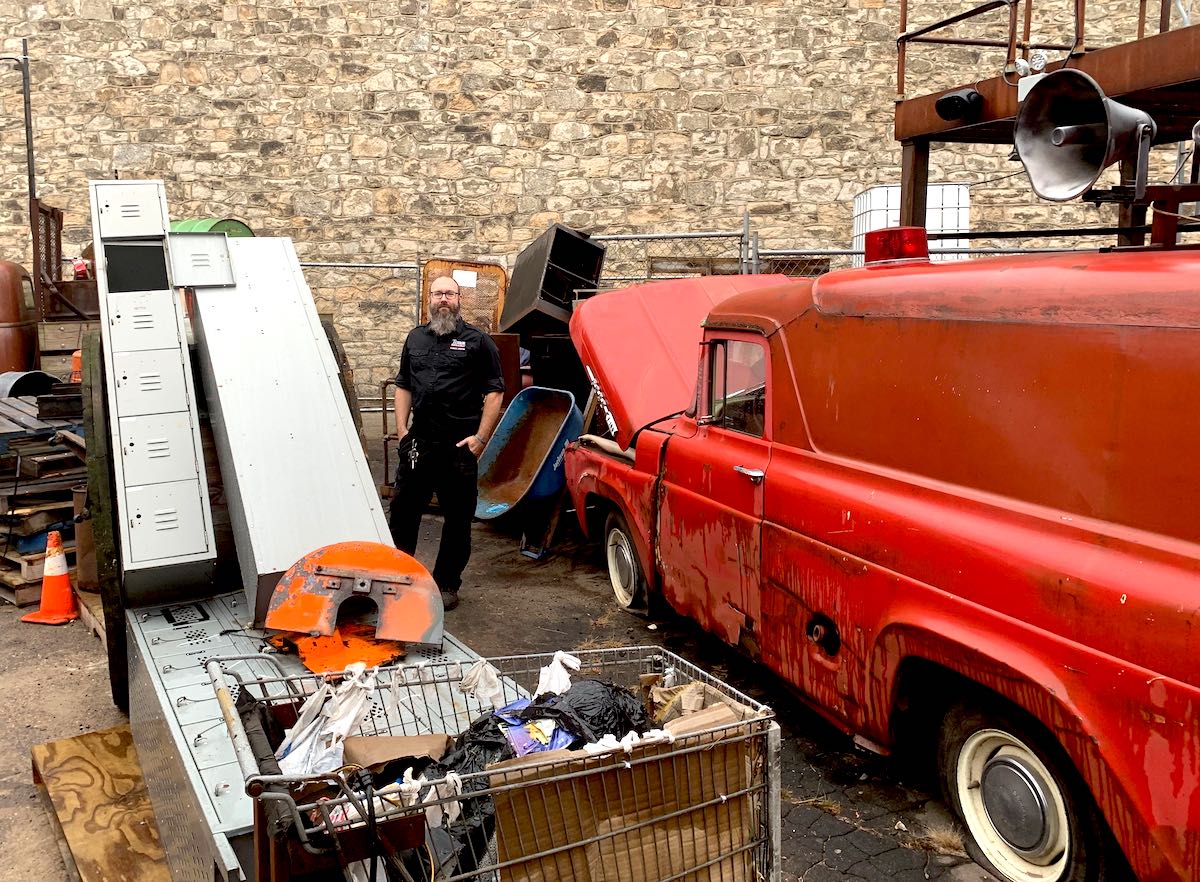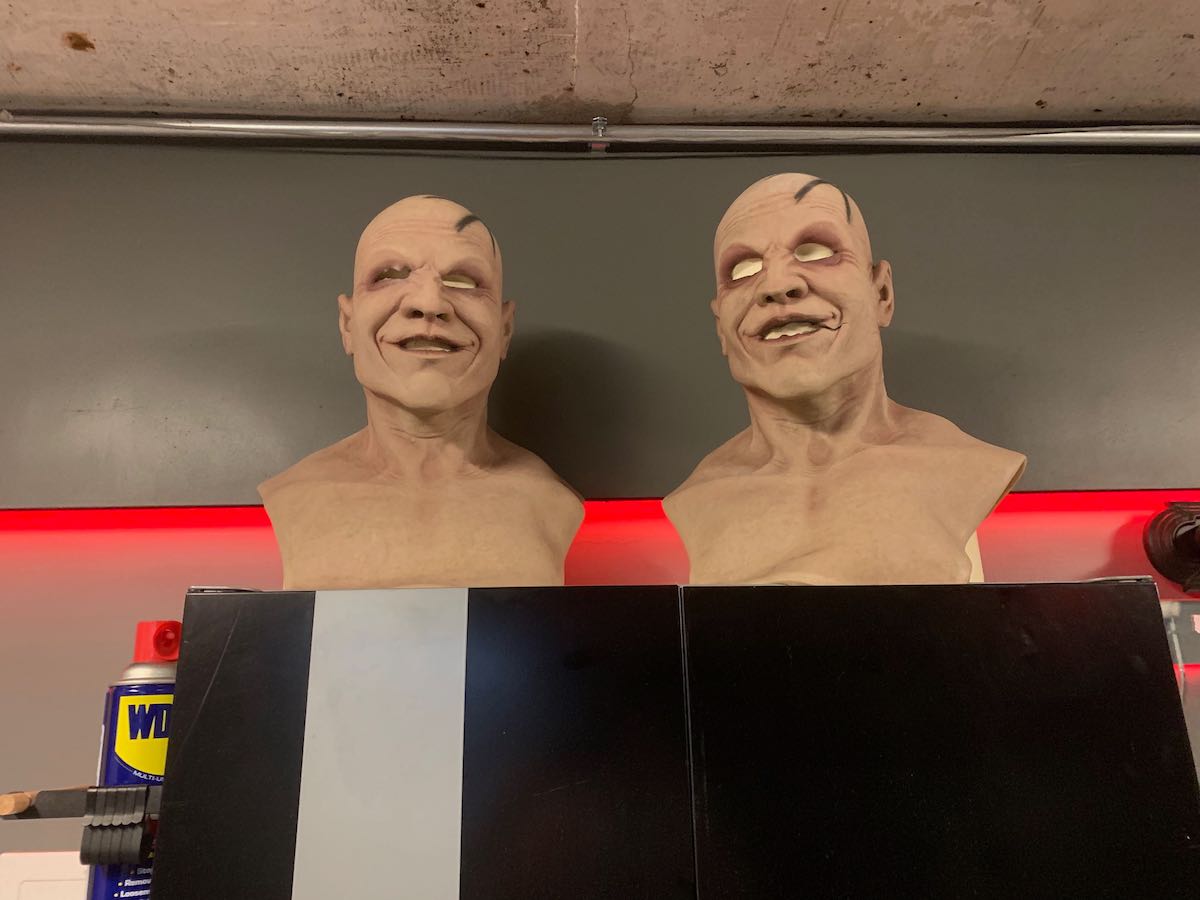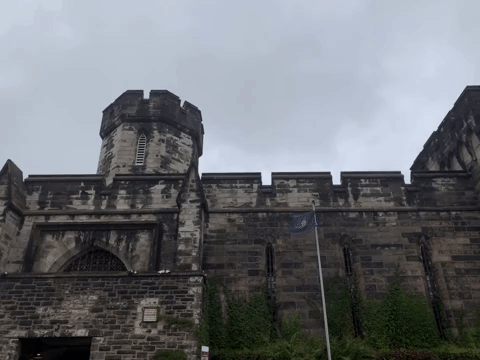It’s not even 10 a.m. when I find myself stepping into an almost pitch-black room and bumping into a dead body hanging from the ceiling.
Thank god I’m doing this tour during the day, I think to myself about one hundred times as I walk through Eastern State Penitentiary’s Terror Behind the Walls attraction with James Travis III, the institution’s associate director of design and facilities engineering. We’re walking the abandoned jail on this drizzly, moody October morning to discuss the technology that powers one of Philadelphia’s most sought-after spooky experiences.
By day, the historic site offers a look into one of the nation’s oldest penitentiaries. But when the museum closes at 5 p.m. during September and October every year, the staff works in less than two hours to turn the space into the creepy, gory, apocalyptic attraction that draws thousands of folks who are willing — and paying — to be scared.
It doesn’t hurt that the building itself is innately eerie, a huge stone and plaster structure that once housed hundreds of prisoners. The Terror Behind the Walls crew leans way into this, and this year, visitors are meant to feel like they’ve entered an abandoned prison during a zombie apocalypse, taking refuge in one of the oldest structures in the city.
The attraction itself has changed quite a bit in its 29 years, first starting as a guided ghost tour throughout halls, and evolving into a compound-wide experience that sees thousands of visitors every season.
Travis tells me others in the biz are envious of the building itself.
“We’re a haunted attraction in an old, historic prison. A lot of people in the haunt industry are extremely jealous of us,” he says. “It does have its issues, but the staff really care about the building itself.”
The issues Travis is referring to come from trying to build thousands of square feet of spooky-ness into a space that can’t be altered. The staff takes the same approach with the attraction as folks do with camping: Leave the space better than you found it.

(Photo by Paige Gross)
The lights, speakers, projections, smoke and mirrors that make the space chilling have to be installed leaving as little footprint as possible. But wiring and radio signals have a hard time traveling through feet of solid stone walls.
When Travis joined Terror Behind the Walls in 2007, the attraction was rigged on a system of programmable logic controllers (PLCs) to control sound effects, lighting and animatronics. They weren’t easy to learn, he says, and in the last few years, the haunt industry and the technology for it have really advanced.
They now use controllers from a Canadian company that Travis say are more intuitive, and can be custom ordered.

One of the Fright Ideas controllers that powers sound and lights. (Photo by Paige Gross)
“We’ll call them and say, ‘I want to be able to do this or time sounds this way,’ and they’ll suggest to us features we didn’t even know were possible,” Travis says.
Now, lighting or sounds can be tuned to an Alexa-like system, and actors can control the atmosphere themselves.
“Actors can time a scare better than anyone else,” he says.
And, if a visitor really wants to, the actors can scare them even more. Visitors can now “opt in” to a more intense experience at the beginning of the tour by wearing a glow necklace throughout, signaling to actors its OK to touch them or pull them into secret passageways.
While we walk through the twisting hallways of the old prison, using a flashlight to illuminate the animatronics and foam characters, Travis points out areas where his team uses motion and reflective light sensors to trigger the timing of a scare. Actors know where they are, so they can step over them, he says.
The team has also had to think about weather. As we duck between buildings, there’s a slight drizzle, and Travis tell me that all the speakers, lights and machines that come in contact with the outside must be fitted for all weather conditions. The actors even have alternate costumes for the rain-or-shine attraction.

Terror Behind the Walls costumes. (Photo by Paige Gross)
At one point during the tour, we enter a school bus that’s supposed to look like it transports prisoners. There’s a tech staff member welding one of the seats, and Travis tells me that both the actors and the visitors can be extremely rough on the set.
He also says that over the last two years, they’ve removed characters that portray prisoners and patients, as depicting them in a haunted house can add stigma to groups of people who already face it in their everyday lives. (Eastern State has made an effort in recent years to be a positive participant in the collective conversation about criminal justice.)
Instead of walking through the bus, we take the accessibility ramp to the next part of the attraction. Terror Behind the Walls is accessible for folks with a range of mobility, and the staff have started adding logos indicating easier-to-navigate paths throughout the attraction so visitors can self-select their route.

James Travis III in a junkyard part of the attraction. (Photo by Paige Gross)
Every day that the attraction is open, three technical shift leaders walk through and do safety checks on each section, testing for working animatronics, fog and any other safety concern.
After climbing through a dark corridor covered in vines (which Travis tells me is supposed to be where those surviving the apocalypse are quarantining folks infected with the zombie virus), we stumble into one of the darkest rooms yet.
I bump into something soft to my left and when I manage to get my phone flashlight back on, I realize we’re in a room with about 10 bodies hanging from the ceiling.
I’m aware of the fact that it’s about 10 a.m. and everything around me is manufactured for haunts, but while Travis is telling me about the smoke mechanism in this room, I can only focus on my heart that’s beating about three times too fast.
So far, I’ve been suspending my disbelief to make it through the rooms of figures, vats of blood and jail cells. But now it’s time to go.
We walk through a corridor that ends in a locked set of doors, and after entering a quick combination, Travis and I stepped right back into the museum and back into the daylight.
As he walks me toward the entrance to the museum, I ask him if he ever gets scared anymore.
“Very rarely,” he says: He goes to other haunted attractions for fun, but he can’t suspend his disbelief long enough to get truly frightened.
I thank him for his time, and we part ways. Even though I now understand the intricacies of what makes this place so frightening to its guests, you still won’t catch me here at night, when the gears are grinding at full steam.
I pass through the giant metal gate that separates Fairmount Avenue from the haunts inside the compound, never more glad to step out into a rainy day.

(Photo by Paige Gross)

(Photo by Paige Gross)

(Photo by Paige Gross)
Join the conversation!
Find news, events, jobs and people who share your interests on Technical.ly's open community Slack

Philly daily roundup: East Market coworking; Temple's $2.5M engineering donation; WITS spring summit

Philly daily roundup: Jason Bannon leaves Ben Franklin; $26M for narcolepsy treatment; Philly Tech Calendar turns one

Philly daily roundup: Closed hospital into tech hub; Pew State of the City; PHL Open for Business


